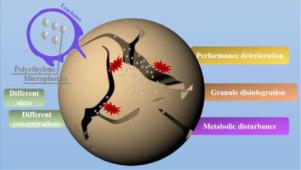Water Research ( IF 11.4 ) Pub Date : 2022-06-14 , DOI: 10.1016/j.watres.2022.118745 Yu-Ting Zhang 1 , Wei Wei 2 , Chen Wang 1 , Bing-Jie Ni 2

|
Micro(nano)plastics is an emerging contaminant in wastewater that has showed significant impacts on various biological treatment processes. Nevertheless, the underlying effects of micro(nano)plastics with different concentrations and sizes on the anaerobic hydrogen-producing granular sludge (HPG) were still unclear. This work firstly attempted to illustrate the microbial and physicochemical responses of HPG to a shock load of polyethylene microplastics (PE-MPs) with varied concentrations and sizes. The results revealed that the PE-MPs inhibitory effect on hydrogen production by HPG was both concentration- and size-dependent. Specifically, the increase of PE-MPs concentration and the decline of PE-MPs size to nano-sized plastics (NPs) significantly decreased the hydrogen yield, downgraded to 79.9 ± 2.6% and 63.0 ± 3.9% (p = 0.001, and 0.0002) of control, respectively, at higher MPs concentration and the smaller MPs size (i.e., NPs). The higher PE-MPs concentration and PE-NPs also suppressed extracellular polymeric substances (EPS) generation more severely. The critical bio-processes involved in hydrogen production were disturbed by PE-MPs, with the extent of negative impacts depending on the dosage and size of PE-MPs. These adverse impacts further manifested as granule disintegration and loss of cellular activity. Mechanism analysis highlighted the roles of oxidative stress, leachate released from PE-MPs, interaction between PE-NPs and granules inducing physical crushing of HPG that led to possible direct contact between cells and toxic substances.
中文翻译:

厌氧产氢颗粒污泥对聚乙烯微(纳米)塑料的微生物和理化响应
微(纳米)塑料是废水中的一种新兴污染物,对各种生物处理过程产生了重大影响。然而,不同浓度和尺寸的微(纳米)塑料对厌氧产氢颗粒污泥(HPG)的潜在影响仍不清楚。这项工作首先试图说明 HPG 对不同浓度和尺寸的聚乙烯微塑料 (PE-MPs) 冲击载荷的微生物和物理化学反应。结果表明,PE-MPs 对 HPG 制氢的抑制作用与浓度和大小有关。具体来说,PE-MPs 浓度的增加和 PE-MPs 尺寸向纳米塑料 (NPs) 的下降显着降低了氢气产率,分别降至 79.9 ± 2.6% 和 63.0 ± 3.9% ( p = 0.001 和 0.0002) 的控制,分别在较高的 MPs 浓度和较小的 MPs 尺寸(即,NPs)。较高的 PE-MPs 浓度和 PE-NPs 也更严重地抑制了细胞外聚合物 (EPS) 的产生。制氢中涉及的关键生物过程受到 PE-MP 的干扰,负面影响的程度取决于 PE-MP 的剂量和大小。这些不利影响进一步表现为颗粒崩解和细胞活性丧失。机理分析强调了氧化应激、PE-MPs 释放的渗滤液、PE-NPs 和颗粒之间的相互作用诱导 HPG 物理粉碎导致细胞和有毒物质之间可能直接接触的作用。











































 京公网安备 11010802027423号
京公网安备 11010802027423号